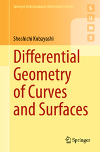- About MAA
- Membership
- MAA Publications
- Periodicals
- Blogs
- MAA Book Series
- MAA Press (an imprint of the AMS)
- MAA Notes
- MAA Reviews
- Mathematical Communication
- Information for Libraries
- Author Resources
- Advertise with MAA
- Meetings
- Competitions
- Programs
- Communities
- MAA Sections
- SIGMAA
- MAA Connect
- Students
- MAA Awards
- Awards Booklets
- Writing Awards
- Teaching Awards
- Service Awards
- Research Awards
- Lecture Awards
- Putnam Competition Individual and Team Winners
- D. E. Shaw Group AMC 8 Awards & Certificates
- Maryam Mirzakhani AMC 10 A Awards & Certificates
- Two Sigma AMC 10 B Awards & Certificates
- Jane Street AMC 12 A Awards & Certificates
- Akamai AMC 12 B Awards & Certificates
- High School Teachers
- News
You are here
Differential Geometry of Curves and Surfaces

Publisher:
Springer
Publication Date:
2019
Number of Pages:
192
Format:
Paperback
Series:
Springer Undergraduate Mathematics Series
Price:
44.99
ISBN:
978-981-15-1738-9
Category:
Textbook
[Reviewed by , on ]
Andrew D. Hwang
03/8/2020
Shoshichi Kobayashi's Differential Geometry of Curves and Surfaces is a spare, focused, and self-contained introduction to differential geometry, aimed at university students who have taken multivariable calculus but not necessarily topology or complex analysis. Originally published in Japanese in 1977, the book was completely revised in 1995, and a chapter on minimal surfaces added. This English translation by Eriko Shinozaki Nagumo and Makiko Sumi Tanaka is based on the 1995 edition of the book.
The author of a textbook on differential geometry faces conflicting pedagogical constraints. The subject's intuitive content relies on a solid foundation in calculus. Definitions tend to be technical, and careful proofs of theorems often rely in key steps on difficult theorems of topology (the Jordan curve theorem, classification of compact surfaces), real analysis (the implicit function theorem, existence and uniqueness theorems for differential equations), complex analysis (the Riemann mapping theorem, the big Picard theorem) and partial differential equations (existence of isothermal parameters). Even when these theorems are granted without proof, differential geometry entails calculations that verge on formidable. The modern machinery of moving frames and exterior calculus is powerful and ultimately simplifying but requires set-up, and the attendant geometric intuition requires experience to extract.
Professor Kobayashi evidently chose his path through the material with care, balancing simplicity against generality, geometric intuition against algebraic machinery, continually pushing readers to extend their mathematical knowledge by incorporating modern idioms of differential geometry.
In addition to numerous illustrations, most sections contain an exercise or few, ranging from computational applications of theory to straightforward proofs, some revisiting earlier material from an alternative viewpoint. Detailed solutions to all the exercises are provided at the end of the book. Though the exercises are of high quality, an instructor teaching from the book will probably wish for more exercises.
Overall, the book reaches admirable destinations with few formal prerequisites and contains enough material for a leisurely one-semester undergraduate course. The book does not cover differential geometry with the same scope as Do Carmo's Differential Geometry of Curves and Surfaces, O'Neill's Elementary Differential Geometry, or Andrew Pressley's Elementary Differential Geometry. In size and focus, Kobayashi's volume compares more closely with Spivak's Calculus on Manifolds. The book's distinctive angle is its bridge between the geometric intuition of a calculus student and the modern machinery and idioms of orthonormal frames and exterior calculus, lightly seasoned with complex analysis and served up by a master geometer of sweeping vision.
Andrew D. Hwang earned his PhD in 1993 at the University of California, Berkeley, under the direction of Shoshichi Kobayashi.
See the publisher's web page.
- Log in to post comments




